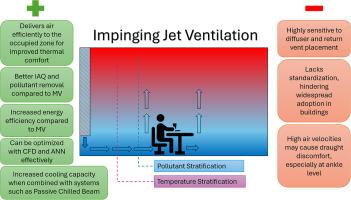A review of impinging jet ventilation for indoor environment control
Q1 Chemical Engineering
引用次数: 0
Abstract
Impinging Jet Ventilation (IJV) has emerged as a promising strategy for indoor environmental control, offering an alternative to conventional such as Mixing Ventilation (MV) systems. This review critically examines the performance of IJV in terms of thermal comfort, indoor air quality (IAQ), energy efficiency, and design flexibility, with a broader focus on the system implementation and a particular focus on office environments under moderate heating and cooling loads. The focus of the review is to compare the IJV system with the MV system. In comparison to MV, IJV delivers conditioned air to the occupied zone more effectively by providing stratified, low-mixing airflow and requiring a lower airflow rate to maintain acceptable thermal comfort conditions. This results in improved thermal comfort, reduced energy usage, and enhanced pollutant removal. The system also facilitates thermal stratification and supports higher supply air temperature differentials, allowing for increased energy savings without compromising comfort. The review explores key performance metrics such as Predicted Mean Vote (PMV), Predicted Percentage of Dissatisfied (PPD), draught rate, and ventilation effectiveness, highlighting the conditions under which IJV outperforms MV. Additionally, challenges such as sensitivity to diffuser configuration, nozzle placement, and return vent positioning are addressed. The paper also evaluates recent advancements, including the integration of Internet of Things (IoT) technologies, machine learning, and hybrid systems combining IJV with passive or personalized ventilation. Despite its advantages, IJV remains underutilized due to design complexity and lack of standardizations. To enable broader adoption, future research should focus on simplified modelling tools, performance-based design standards, and scalable applications for various building types. Overall, IJV represents a viable, energy-efficient solution for modern ventilation design, particularly in environments requiring high indoor air quality and localized comfort control.

冲击射流通风在室内环境控制中的研究进展
撞击式射流通风(IJV)已成为室内环境控制的一种有前途的策略,为传统的混合通风(MV)系统提供了替代方案。本综述从热舒适、室内空气质量(IAQ)、能源效率和设计灵活性等方面对IJV的性能进行了严格的审查,并对系统实施进行了更广泛的关注,特别关注了中等冷热负荷下的办公环境。本文的重点是比较合资企业制度和MV制度。与MV相比,IJV通过提供分层、低混合的气流,并需要更低的气流速率来保持可接受的热舒适条件,从而更有效地将空调空气输送到占用区域。这改善了热舒适性,减少了能源使用,并增强了污染物的去除。该系统还有助于热分层,并支持更高的送风温差,从而在不影响舒适性的情况下增加节能。该审查探讨了关键绩效指标,如预测平均投票(PMV)、预测不满意百分比(PPD)、通风率和通风效率,强调了IJV优于MV的条件。此外,还解决了对扩散器配置、喷嘴位置和回排气口位置的敏感性等挑战。本文还评估了最近的进展,包括物联网(IoT)技术的集成、机器学习以及将IJV与被动或个性化通风相结合的混合系统。尽管具有优势,但由于设计复杂性和缺乏标准化,IJV仍未得到充分利用。为了实现更广泛的应用,未来的研究应该集中在简化建模工具、基于性能的设计标准和各种建筑类型的可扩展应用上。总体而言,IJV为现代通风设计提供了可行的节能解决方案,特别是在需要高室内空气质量和局部舒适控制的环境中。
本文章由计算机程序翻译,如有差异,请以英文原文为准。
求助全文
约1分钟内获得全文
求助全文
来源期刊

International Journal of Thermofluids
Engineering-Mechanical Engineering
CiteScore
10.10
自引率
0.00%
发文量
111
审稿时长
66 days
 求助内容:
求助内容: 应助结果提醒方式:
应助结果提醒方式:


